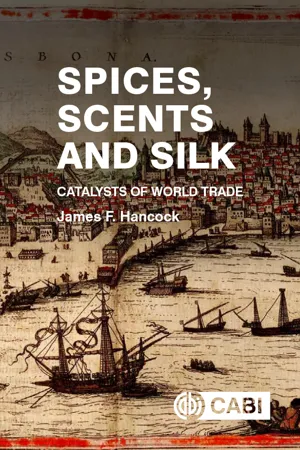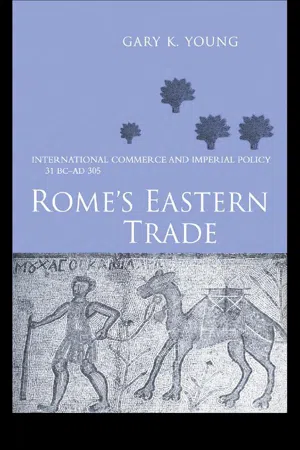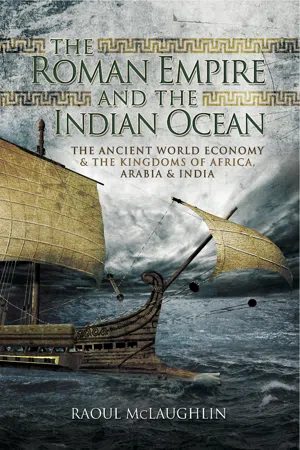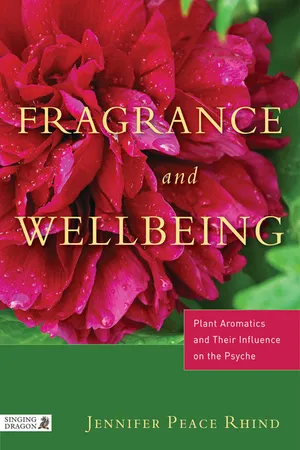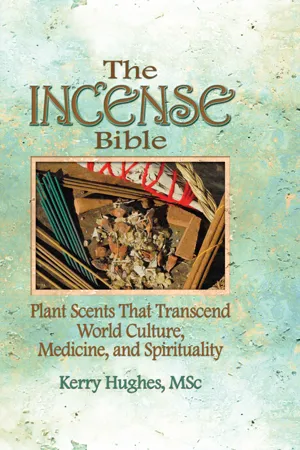History
Incense Route
The Incense Route was a network of ancient trade routes used to transport frankincense and myrrh from southern Arabia to the Mediterranean, passing through various regions including the Arabian Peninsula, Egypt, and the Levant. This trade route played a significant role in the exchange of goods, culture, and ideas between the East and the West during antiquity.
Written by Perlego with AI-assistance
Related key terms
Related key terms
1 of 4
Related key terms
1 of 3
6 Key excerpts on "Incense Route"
- eBook - ePub
Spices, Scents and Silk
Catalysts of World Trade
- James Hancock(Author)
- 2021(Publication Date)
- CAB International(Publisher)
Fig. 5.2 ). All these cities were centred where important valleys entered the plain.The frankincense after harvest was first transported by camels to Shabwa (Shabwah today), where Pliny tells us:Fig. 5.2. Incense Routes through ancient Arabia. (Redrawn from Singer, C. (2006) The incense kingdoms of Yemen: an outline history of the South Arabian incense trade. In: Peacock, D.P.S. and Williams, D.F. (eds) Food for the Gods: New Light on the Ancient Incense Trade. EBSCO Publishing, Ipswich, Massachusetts, Figure 2.6.)a single gate is left open for its admission. To deviate from the high road while conveying it, the laws have made a capital offence. At this place the priests take by measure, and not by weight, a tenth part in honour of their god, whom they call Sabis; indeed, it is not allowable to dispose of it before this has been done: out of this tenth the public expenses are defrayed, for the divinity generously entertains all those strangers who have made a certain number of days’ journey in coming thither.(Bostock and Riley, 1855 –57, 12.32)When the taxes had been paid, the merchants purchased their supplies for the northern journey. In the beginning, the merchants were not from Shabwa, but from the Kingdom of Ma’in. These traders were well known all across the civilized world and were responsible for the shipment of incense to Syria, Egypt and Assyria, and then Greece and Rome. Settlements of Minaean traders from the Mediterranean were also established at key points along the Incense Route, as well as in Egypt.The caravan routes were lined by a series of way stations along the way, each collecting its own taxes (Singer, 2006 ). As Pliny further relates, ‘all along the route, there is at one place water to pay for, at another fodder, lodging at the stations, and various taxes and imposts besides’ (Bostock and Riley, 1855 - eBook - ePub
Rome's Eastern Trade
International Commerce and Imperial Policy 31 BC - AD 305
- Gary K. Young(Author)
- 2003(Publication Date)
- Routledge(Publisher)
3 THE ARABIAN INCENSE TRADE
Like the sea trade into Egypt, the overland trade in aromatics which reached Arabia already had a long history by the time of the Roman entry into the affairs of the East in the first century BC. The Arabian perfumes of frankincense and myrrh had long been prized among the peoples of the Near East, and were an important part of both Near Eastern and Mediterranean religious practices. Accordingly, a strong market already existed for these commodities in the Mediterranean world, and the inhabitants both of the incense-producing regions and of those regions on the trade routes were able to exploit this market to their advantage.Many of the trade routes between southern Arabia and the Mediterranean crossed the Nabataean kingdom. By the time of the Romans’ appearance in the East, the Nabataeans were heavily involved in this trade and had attained considerable wealth and power.1 In this chapter, we shall examine the sources of the incense and the routes by which it was carried into and throughout the kingdom. From this, and from the other evidence of the trade which can be assembled, we shall attempt to determine what effect the trade had upon the societies of Nabataean and Roman Arabia, and upon political developments in those spheres.The trade routes of the Nabataean kingdom
The Nabataeans, who may have originated in the Arabian peninsula,2 occupied the area south and east of the Dead Sea by the fourth century BC. By the first century BC they had expanded to become a wealthy and powerful kingdom by their control and exploitation of caravan routes through their territory. In the first literary reference to the Nabataeans, Diodorus Siculus refers to their wealth and its source:Although there are not a few of the Arab tribes using the desert as pasture, these greatly exceed the others in wealth, being not much more than ten thousand in number. For not a few of them are accustomed to bring down to the sea frankincense, myrrh and the most valuable of the aromatics which they receive from those who carry them from Arabia called Eudaimon.3 - eBook - ePub
The Roman Empire and the Indian Ocean
The Ancient World Economy & the Kingdoms of Africa, Arabia & India
- Raoul McLaughlin(Author)
- 2014(Publication Date)
- Pen & Sword Military(Publisher)
CHAPTER THREE
Incense: A Unique Product
In the ancient world many regions had unique natural products that were valuable commodities in distant markets. Traders, traffickers and consumers were all prepared to pay large sums to obtain these goods. Foremost among these unique products was the incense formed from fragrant, hardened resin of certain trees that grew in hot, arid climates. Most incense trees were subject to particular environmental conditions and could only be grown in certain regions. Incense was a renewable crop and since it was a sap, it was rarely diminished by ‘poor’ yields caused by seasonal fluctuations in annual weather patterns.Incense became a necessity for religious observance in places far from its place of origin, so transport systems were created to deliver this valuable crop to consumer markets. The demand for incense was large-scale and the markets to be supplied covered the entire ancient world from Western Europe to the cities of Han China. Incense stocks were so valuable that even a moderate amount was usually purchased using silver or gold. In the first century AD, Pliny the Elder records that the best frankincense was valued in Roman markets at 10 silver denarii per pound, while a similar weight of the finest resin-oil myrrh (stacte ) could sell for up of 50 denarii (200 sesterces).1 To give context to this figure, 200 sesterces represents about fifty day’s pay for a skilled labourer in the first century AD.2Incense production therefore had an important impact on world resources and increased the prosperity of the regimes engaged in this trade. Nations that controlled the incense trade had a continuous source of revenue that offered them an important and dependable long-term advantage in world commerce. Myrrh and frankincense in particular were renewable crops that brought great wealth into territories near the Gulf of Aden. By contrast, civilisations like Rome and Parthia had no equivalent product that could meet the cost of their incense imports and therefore had to rely on finite bullion reserves to pay for their consumerism. - eBook - ePub
Food for the Gods
New Light on the Ancient Incense Trade
- D. P. S. Peacock, A. C. S. Peacock, David Williams, A. C. S. Peacock, David Williams(Authors)
- 2006(Publication Date)
- Oxbow Books(Publisher)
Chapter 2: The Incense Kingdoms of Yemen:
An Outline History of the South Arabian Incense Trade
Caroline SingerThe overland trade in aromatics between South Arabia–that is, principally, the kingdoms of pre-Islamic Yemen–and the civilizations of Mesopotamia, Assyria, the Levant, the Mediterranean and Egypt, began in earnest at the start of the 1st millennium BC, and had an incalculable effect on the economic, cultural and linguistic life of the Middle East. However, even a cursory search among the sacred literature of ancient Egypt and Sumeria, Old Testament texts or the cuneiform records of Mesopotamia, reveals the importance of incense for religious and royal ceremonies long before the frankincense merchants started to arrive with their camel-trains from southern Arabia, in c. 10th to 8th century BC. The very early use of incense in Egypt, Greece, Mesopotamia and the Fertile Crescent, at least from the third millennium onwards, relied on sources much closer to home. The ‘incense’mentioned so often in the Pentateuch1 - eBook - ePub
Fragrance and Wellbeing
Plant Aromatics and Their Influence on the Psyche
- Jennifer Peace Peace Rhind(Author)
- 0(Publication Date)
- Singing Dragon(Publisher)
et al. 2010).Gilman and Xun (2004) estimate that incense use began five or six thousand years ago. Julia Lawless (1994) conducted her literature research at the Warburg Institute in London, which specialises in classical antiquity and its influences on western culture (Steele 1994), and from this suggested that the earliest use of incense was in ancient China, followed by the Hindus, who would have created the first incense trail to Arabia and Egypt.She also mentions that the use of incense in Egypt dates back to almost prehistoric times (Lawless 1994). The earliest written evidence would suggest that sntr , which translates as the word ‘incense’, was known from the Early Dynastic times, 2920–2575 BCE onward. This is the first mystery we are confronted by – we do not know the botanical identity of sntr . It is often juxtaposed with the word ’ntyw , which led to the widespread belief that the ancient texts were referring to what we now call frankincense and myrrh. However, these core incenses are resins that were not indigenous to Egypt, and so this mystery has led to collaborative research between archaeologists and botanists. Frankincense and myrrh are gum-resins associated with Arabia, and it was thought that the ancient Egyptians imported their incense from Punt. Inscriptions on the temple of Queen Hatshepsut at Thebes indicate that she attempted to bring back ‘incense trees’ from Punt. The location of Punt is not clear, but is might have been the land between the eastern Sudan and the northwestern Ethiopian highlands, now modern Eritrea, where frankincense and myrrh trees still grow. Later, New Kingdom texts (1558–1085 BCE ) make reference to sntr being imported from Syria and Palestine, but frankincense trees do not grow here, and myrrh is rare in this region. So, it has been suggested that sntr was the resin of a species in the genus Pistacia (which contains the familiar pistachio nuts), as originally proposed by Loret (1949) and later confirmed as P. atlantica - eBook - ePub
The Incense Bible
Plant Scents That Transcend World Culture, Medicine, and Spirituality
- Dennis J Mckenna, Kerry Hughes(Authors)
- 2014(Publication Date)
- Routledge(Publisher)
In Roman times incense was burned before the statues of gods during procession, and were left either in doorways along the procession route or carried by hand. Incense was even a part of the Circensian games, which included a procession of dancers and musicians followed by people carrying gold and silver censers with various religious and civil signs inscribed on them, followed by people carrying the images of gods. In the procession for the goddess Isis, a large number of people carried candles and torches, while priests carried lanterns and an altar. At the head of the procession were women who wore garlands of flowers, and people who strewed herbs, balm, and other fragrant substances (Atchley, 1909).In earlier Roman times, it was not customary to burn the dead but to bury them. However, before the burial the body was washed and anointed. Later it became customary for the bodies of the dead to be cremated, and in some instances large quantities of incense and other spices were brought to the cremations. There is one story of a cremation in which large statues of frankincense and cinnamon were created of the departed and then burned on the pyre (Atchley, 1909).Arabian SecretsThe ancient trade routes of frankincense and myrrh were traveled by camel and kept secret from outsiders. The exact location of where frankincense and myrrh trees grew was surrounded by so much myth and secrecy that the outside world had no access to these trees. In the ancient land of Sheba—what is today Yemen and Oman—is the place where frankincense and myrrh trees originated. They grew only in the hot, stony, and lime-enriched desert belt that was protected from wind by the mountains. This was also native territory for other incense plants—such as balsam and cinnamon—all of which made the inhabitants of the Arabian region very wealthy. The beginning of the 2,200 mile trade route through the desert began in the town of Ma’rib, at the eastern corner of the foothills of Yemen. An oasis was located in the middle of the town, and large walls surrounded and protected it.The Love of the ProphetAccording to the prophet of Islam, Mohammed, he loved three things the most in this world: women, pleasant fragrances, and prayer. The most loved of the fragrances by Mohammed was musk. Musk comes from the scent gland of a deer, and when it is concentrated it smells of urine and ammonia, but when it is highly diluted it becomes an earthy and sensuous fragrance (Fischer-Rizzi, 1996). Yemeni women still use incense to perfume their clothing with musk, aloeswood, sandalwood, clove, and rose. Muslim women use an incense mixture called bakhur, which is made by the family to scent their burkas and chadors . The incense has a rose water and sugar base, and consists usually of the aforementioned incenses, as well as ground up conch shells called duffer
Index pages curate the most relevant extracts from our library of academic textbooks. They’ve been created using an in-house natural language model (NLM), each adding context and meaning to key research topics.
Explore more topic indexes
Explore more topic indexes
1 of 6
Explore more topic indexes
1 of 4
